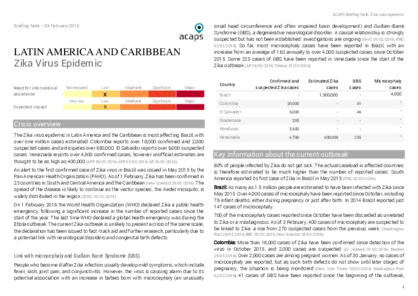Latest updates on country situation
18 November 2025
On 7 November 2025, a tornado with winds between 250–300km/h struck the town of Río Bonito de Iguaçu in southern Parana state, Brazil, potentially affecting more than 13,000 people – the town’s entire population – including at least six dead, 800 injured, and around 1,000 displaced. The tornado also damaged or destroyed 90% of all buildings in the town, including schools, health facilities, and critical infrastructure, such as electricity and water supply systems, which were severely damaged. Communication systems and transport routes have also been damaged, limiting the ability of government institutions and international aid providers to reach all affected people. Information on the specific needs of those affected remains limited, but the main humanitarian needs likely include access to emergency shelter for all displaced people, WASH services, access to emergency food kits, and the restoration of main roads and public buildings to ensure relief distribution. (Latin America Post 14/11/2025, Reuters 08/11/2025, IOM 13/11/2025)
10 September 2024
Since October 2023, Amazonas state has been experiencing a drought that has led to the declaration of a state of emergency in all 62 of its municipalities. This has been the worst drought in the state in over 40 years. By late 2023, it had affected an estimated 600,000 people, a figure projected to reach over 1.2 million by the beginning of 2024. Although the current number of people affected is unknown, recent reports suggest a worsening of the situation, especially for riverine communities. Low river levels have stranded dozens of communities only accessible by water, limiting access to food, fuel, medicine, and basic services, such as healthcare and education. Owing to shortages of potable water, reports of illnesses, especially among children, because of unsafe water consumption have increased in some areas. Prolonged drought conditions may aggravate healthcare needs in communities already struggling to access basic services. (Brazil Government 05/09/2024, BdF 09/09/2024, PAHO accessed 11/09/2024)
20 May 2024
By 16 May 2024, floods had affected 2.2 million people in the southern state of Rio Grande do Sul in Brazil. Of these, 500,000 were displaced and one million faced intermittent access to drinking water and electricity. Although there are 27,000 state personnel deployed in the rescue mission and the country is receiving help from international responders, the number of people affected probably surpasses the aid currently available. (OCHA 20/05/2024, MSF 20/05/2024)
07 May 2024
Since 27 April 2024, record rainfall linked to El Niño has caused unprecedented flooding in Brazil's southern state of Rio Grande do Sul, killing at least 95 people by 7 May. The flooding displaced 208,000 people and affected at least 1.5 million across the state. Floods had also deprived more than 1.4 million people of electricity and cut off telecommunications in 48 cities. The inundation of roads has isolated some towns and disrupted transportation. The flooding has also affected the states of Parana and Santa Catarina, increasing the number of casualties. More rainfall is expected in the coming days. The full impact of the floods is still unknown, but those affected are likely to need food, shelter, and WASH assistance. (WMO 06/05/2024, ECHO 08/05/2024, The Guardian 06/05/2024)
08 April 2024
As at 3 April 2024, heavy rainfall in the northeastern state of Maranhão had displaced at least 2,300 people. As a result, at least 13 municipalities had declared a state of emergency. Maranhão faced the same consequences from heavy rains around the same period in 2023, with 7,000 people left homeless and 35,000 families affected. (ERCC accessed 09/04/2024, PAHO 03/04/2024, The Brazilian Report 25/04/2023)
08 February 2024
In 2024, the states of Acre, Goias, and Minas Gerais and the Federal District of Brazil have declared a state of emergency in response to rising cases of dengue fever. The city of Rio de Janeiro has reported 10,000 cases alone, nearly half of all the cases reported in 2023. Although Brazil has tackled the situation by opening new healthcare facilities and spraying areas with high concentrations of mosquitoes, the communities residing far from major cities, the communities residing far from major cities could require humanitarian assistance in the form of WASH and medical services. (AP 08/02/2024, Expansion 07/02/2023, Reuters 08/02/2024)
22 November 2023
Drought is currently affecting an estimated 600,000 people in Amazonas state. As at 30 October 2023, 60 of the 62 municipalities in the state had been declared to be facing emergency drought levels. The drought is driven by El Niño, combined with deforestation and the above-average warming of the water in the northern Atlantic Ocean. As a result, the water levels in the Rio Negro River are the lowest in 120 years, affecting people’s access to services, including food, healthcare, and education. The affected population are left isolated, driving displacement, as the people often use the river to transport basic food and medicine, as well as passengers to where there are available services, such as schools and health facilities. About 12,300 people (3,000 families) are displaced and staying in emergency shelters. Clean drinking water is needed, as wells have dried up and water pumps are not functioning. (UNICEF 25/10/2023, PAHO 31/10/2023, Nature 14/11/2023)
current crises
in
Brazil
These crises have been identified through the INFORM Severity Index, a tool for measuring and comparing the severity of humanitarian crises globally.
BRA002 - Displacement from Venezuela
Last updated 27/11/2025
Drivers
International Displacement
Crisis level
Country
Severity level
2.5 Medium
Access constraints
1.0
Analysis products
on
Brazil
28 January 2025
Brazil: impact of drought in the Brazilian Amazon and 2025 outlook
DOCUMENT / PDF / 992 KB
This report analyses of the impact of the drought in Brazil, focusing on affected Amazon communities in northwest and central Brazil, primarily in the states of Acre, Amazonas, Mato Grosso, Pará, and Rondonia.
Attached resources
14 May 2024
Brazil: floods in Rio Grande do Sul
DOCUMENT / PDF / 849 KB
Since 27 April, the southern Brazilian states of Paraná, Rio Grande do Sul, and Santa Catarina have been affected by heavy rains. As at 12 May, at least 143 people had died, 806 were injured, 130 were still missing, and almost 54,000 had been displaced.
04 February 2022
Brazil: Floods in Bahia and Minas Gerais
DOCUMENT / PDF / 510 KB
Because of a meteorological phenomenon known as the South Atlantic Convergence Zone, the Brazilian states of Bahia and Minas Gerais have been experiencing heavy rainfall since early December. The rains have caused flooding in 164 municipalities in Bahia and 341 in Minas Gerais. As at 25 January, more than 965,000 people in both states are affected.
08 June 2017
Brazil: Floods in Pernambuco and Alagoas
DOCUMENT / PDF / 126 KB
In the last week of May, heavy rainfall and flooding were registered across the states of Pernambuco and Alagoas in northern Brazil. In Pernambuco, 24 out of 185 municipalities have declared state of emergency: 55,000 have been displaced and up to 2.2 million temporarily affected by damage to WASH infrastructure. In Alagoas, the highest estimates are of 16,000 people displaced and 27 out of 102 municipalities in state of emergency.
18 March 2016
Latina America and Caribbean: Zika Virus Epidemic
DOCUMENT / PDF / 166 KB
The Zika virus epidemic in Latin America and the Caribbean is most affecting Brazil, with over one million cases estimated. Colombia reports over 18,000 confirmed and 2,000 suspected cases and anticipates over 650,000. El Salvador reports over 6,000 suspected cases. Venezuela reports over 4,500 confirmed cases, however unofficial estimates are thought to be as high as 400,000.






